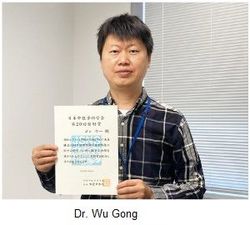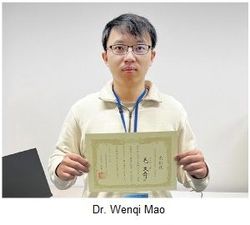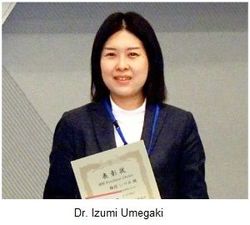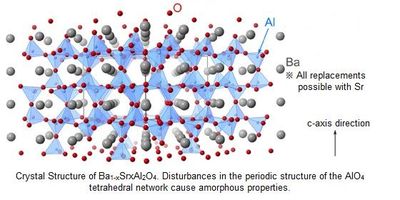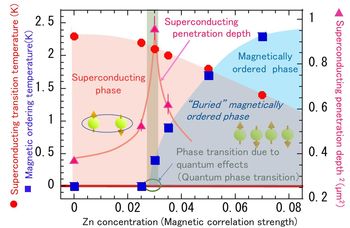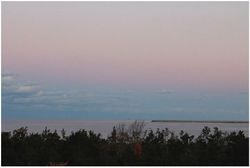J-PARC News January 2023 (Issue #212)
■Dr. Wu Gong Receives "Young Researcher Prize" from Japanese Society for Neutron Science
Dr. Wu Gong of the Neutron Source Section, Materials and Life Science Division received the 20th "The JSNS Young Researcher Prize" from the Japanese Society for Neutron Science for his outstanding achievement in "Research on Microstructure Control and Mechanical Properties of Advanced Structural Materials using Pulsed Neutron Diffraction". He has investigated microstructure evolutions during thermal processes and deformation at various temperatures to elucidate the relationship between the microstructure and deformation behavior in various metallic materials covering conventional steels, advanced high strength steels, and also light magnesium alloys, using in situ pulsed neutron diffraction experiments, conducted at the engineering materials diffractometer, TAKUMI, of BL19 at the Materials and Life Science Experimental Facility in J-PARC and the neutron diffractometer, ENGIN-X, at the Rutherford Appleton Laboratory in the U.K. Among the award-winning achievements, he has clarified that the LPSO phase is a dynamically stable phase, quantified for the first time in the world the mutual stress of the αMg and LPSO phases in a Mg-based LPSO-type (long-period stacking ordered structure) 2-phase alloy, and elucidated that the LPSO phase behaves as a hard phase.
For more information, please visit the J-PARC website.
https://j-parc.jp/c/topics/2022/11/15001050.html
■Dr. Wenqi Mao Receives “Poster Award” from Japanese Society for Neutron Science
Dr. Wenqi Mao of the Neutron Source Section, Materials and Life Science Division received the 20th "Poster Award" from the Japanese Society for Neutron Science.
He won the award for his presentation on the metastable austenitic steels that have attracted much attention in the industrial field due to their excellent deformation capability and corrosion resistance. He has found that the strength of metastable austenitic steel consisting ultra-fine size of crystal grains was much improved with keeping the elongation as large as the steel of coarse crystal grains. He has also elucidated the relationship of refining crystal grain size to the strength increase with large elongation of the steels using in situ neutron diffraction experiments during tensile deformation at the "TAKUMI" of BL19 of the MLF in the J-PARC.
Ultrafine-grained (UFG) metastable austenitic steels are well known to have an excellent combination of strength and ductility, facilitated by deformation induced martensitic transformation (DIMT). Although it is known that grain refinement alters the rate of DIMT and thus has a significant effect on the deformation behavior of metastable austenitic steels, the effect of grain refinement on DIMT has not been fully elucidated. Mao and his colleagues, therefore, performed in situ neutron diffraction measurements during the deformation of an UFG metastable austenitic steel and found that the difference in DIMT initiation among differently oriented austenite grains increases as the grain size becomes ultrafine. In other words, austenite grains with crystallographic orientations in which DIMT is difficult to initiate become more difficult to martensitic-transform by refining crystal grain size in metastable austenitic steels.
For more information, please visit the J-PARC website.
https://j-parc.jp/c/topics/2022/11/18001055.html
■Dr. Izumi Umegaki Receives "Hamon President’s Choice Award" from Japanese Society for Neutron Science
Dr. Izumi Umegaki of the Muon Section, Materials and Life Science Division, received the "Hamon President’s Choice Award" from the Japanese Society for Neutron Science.
The president of JSNS selects the Hamon President Choice Award every two years from science articles, feature articles, technical notes, and articles about introductory lectures published in Hamon, the official journal of the Japanese Society for Neutron Science. The award-winning article by Dr. Umegaki, "Application of Muon Beam for Li-ion Battery Research," was published in Hamon Vol. 31. No. 3113 (2021).
For more information, please visit the KEK website.
https://www2.kek.jp/imss/news/2022/topics/1114hamon-president-choice/
■Winners of Annual Presentation Awards at 19th Annual Meeting of Particle Accelerator Society of Japan
Two research fellows won the Annual Presentation Awards at the 19th Annual Meeting of the Particle Accelerator Society of Japan.
The Accelerator Society of Japan has established the Annual Presentation Awards for outstanding presentations during the Annual Meeting to encourage students and young researchers in the initial stages of their research activities and careers.
[Oral Presentation]
Mr. Motoki Chimura from Accelerator Section 3 of the Accelerator Division, JAEA’s research fellow belonging to Tohoku University, won an award in the oral presentation category.
In the low energy region of the linac, a strong space charge field causes a rapid emittance growth (the beam’s spread in phase space, a measure of beam quality). To mitigate this emittance growth, a research group to which Mr. Chimura belongs has proposed the addition of a nonlinear magnetic field to the beamline. To experimentally demonstrate this proposal, the group developed a composite multipole magnet that can generate a nonlinear magnetic field and a quadrupole magnetic field. By shorting the magnetic circuit of the magnet, the research group has devised a combined multipole magnet that can generate a quadrupole magnetic field equivalent to that of a pure quadrupole magnet and has realized an electromagnet that can cause a nonlinear field while having the same size and focusing force as an existing quadrupole magnet.
Title: "DEVELOPMENT OF QUADRUPOLE-OCTUPOLE COMBINED MAGNET FOR EMITTANCE-GROWTH MITIGATION IN THE J-PARC LINAC"
Author:Motoki Chimura, Hiroyuki Harada, Tomohiro Takayanagi, Michikazu Kinsho
[Poster Presentation]
Mr. Shota Nagayama from Accelerator Section 2 of the Accelerator Division, JAEA’s research fellow belonging to Tohoku University, won an award in the Poster Presentation category.
To achieve non-destructive beam extraction from the ring, a research team to which Mr. Nagayama belongs is developing a new device, a non-destructive electrostatic septum, which contains no material in the beam orbit. The spatial distribution of the electric field, like a step function, is ideal for separating the extracted beam from the circulating beam with a minimal negative impact on the ring orbiting beam. The device, which consists of an anode, cathode, and guide electrode, allows the formation of a step-function-like electric field. They devised a method for determining the voltage applied to the electrodes using a least-squares optimization method.
In addition, a new "electric and magnetic field generation function combined type" is proposed to improve the separation between these beams by applying an additional magnetic field.
Title: "STUDY OF NON-DESTRUCTIVE SLOW BEAM EXTRACTION METHOD IN PARTICLE ACCELERATOR"
Author: Shota Nagayama, Hiroyuki Harada, Tetsuji Shimokawa, Ippei Yamada, Motoki Chimura, Kazami Yamamoto, Michikazu Kinsho
■First Detection of Lithium-ion motion in Lithium-ion Battery during Charge and Discharge Reactions (October 19)
A research group of Neutron Science and Technology Center, Comprehensive Research Organization for Science and Society (CROSS), Faculty of Science Division 1, Department of Applied Chemistry, Tokyo University of Science, and Institute of Materials Structure Science, KEK has succeeded for the first time in the world in measuring the self-diffusion coefficient, an indicator of the speed for lithium ions jump and movement with thermally activated energy in a lithium-ion battery during charge and discharge reactions, using the general purpose µSR spectrometer, ARTEMIS at MUSE MLF J-PARC.
Ions carry electric charges in a battery. Therefore, the diffusion coefficient of ions is one of the crucial parameters that determine battery performance and has been conventionally measured by an electrochemical technique. However, the electrochemical measurement does not provide intrinsic diffusion coefficients but provides apparent diffusion coefficients that include the reactive surface area where battery reactions occur. Therefore, the research group has focused on the muon spin rotation relaxation (µSR) technique. Then the team has developed a special half-cell to investigate the diffusion coefficient in a lithium-ion battery during charge and discharge reactions (see Fig.1). As a result, the variation of the self-diffusion coefficient of lithium ions in LixCoO2, the most common cathode material, was determined as a function of the lithium content x.
This research is expected to contribute not only to the understanding and improvement of the operation mechanism of current lithium-ion batteries but also to the search for next-generation battery materials and the optimization of electrode preparation methods. The results were published online in ACS Applied Energy Materials by the American Chemical Society on October 4, 2022.
For more information, please visit the J-PARC website.
https://j-parc.jp/c/press-release/2022/10/19001035.html
■Expected to Applied to Space Industry! Discovery Crystalline Solid, Ba1-xSrxAl2O4, Near Structural Quantum Critical Point has both Properties of Crystal and Glass (October 28)
A research group of the Graduate School of Engineering of Osaka Metropolitan University, the National Institute for Materials Science, the Institute for Materials Research of Tohoku University, the J-PARC Center, and the Japan Synchrotron Radiation Research Institute has discovered that specific atomic vibrations of Ba1-x SrxAl2O4, a crystalline solid, can be in a state that has both properties of the crystal and glass.
Structural phase transition is a phenomenon in crystalline solids that the crystal structure changes discontinuously. By controlling the chemical composition of the crystal, structural phase transitions, which generally occur at finite temperatures, can be achieved even when the temperature is lowered to absolute zero. This phase transition point is called the “structural quantum critical point.” In this study, the research team focused on the crystalline solid Ba1-xSrxAl2O4, which exhibits a structural phase transition due to atomic vibration with a sound wave-like vibration pattern to analyze the crystal structure and atomic vibration state near the structural quantum critical point (x = 0.1), using techniques of the synchrotron radiation and neutrons. As a result, it was found that Ba1-xSrxAl2O4 for x > 0.1 forms a hybrid structure of a periodic arrangement of the Ba atoms (characteristic of crystals) and a glassy AlO4 network and thus shows thermal properties typically observed in glass materials, even though it is a crystalline solid.
This state can occur in various materials by a simple process of uniformly mixing and heating raw materials. Therefore, such hybrid materials that combine the optical properties and the electrical conductivity in crystals and the low thermal conductivity in glass materials can be realized, and then are expected to be applied to the space industry, such as heat insulating materials for rockets. For more information, please visit the J-PARC website.
https://j-parc.jp/c/press-release/2022/10/28001043.html
■Observation of Weak Magnetism Deep Inside Superconducting Phase
-Progress Toward Elucidating Mechanism of Superconductivity (November 29)
A research group of JAEA, Ibaraki University, Kyoto University, Université Grenoble Alpes of France, Tokyo Institute of Technology, J-PARC Center, and Institute for Molecular Science of National Institutes of Natural Sciences, has observed the appearance of a magnetic state in a cerium-based superconducting compound CeCo(ln, Zn)5 near absolute zero temperature.
In conventional superconductors, it is well known that lattice distortion plays an essential role for the appearance of superconductivity. However, for several kinds of superconductors, magnetism is thought to play an important role, but until now, no clear evidence has been found. In a cerium compound, CeCo(ln, Zn)5, the magnetic coupling between the cerium spins can be controlled by slightly substituting the In atom in CeColn5 to a Zn atom. The samples were cooled down to a very low temperature, and superconductivity and magnetism were investigated by using muon spin rotation/relaxation methods at J-PARC.
As a result, it was observed that the superconducting transition temperature decreased with increasing Zn content, and a magnetically ordered state appeared deep inside the superconducting phase. This result clarifies that phase transition caused by site substitution occurs at absolute zero temperature and quantum origin. Furthermore, at the Zn concentration where the magnetic ordering occurs, the superconducting penetration depth shows a clear peak, indicating that the magnetism is strongly correlated to the superconductivity.
This result indicates that magnetism due to quantum effects plays a significant role in the emergence of superconductivity, leading to the elucidation of the relationship between the magnetic and the possible mechanism of the emergence of superconductivity. It is expected to lead to a broader range of basic science and industrial applications, such as incrementing an onset temperature of superconductivity. The result has been published in the Proceedings of the National Academy of Sciences of the United States of America (PNAS).
For more information, please visit the J-PARC website.
https://j-parc.jp/c/press-release/2022/11/29001079.html
■ J-PARC Hello Science “Part 2: Do Hypernuclei Exist in the Universe?” (November 25)
The November "Hello Science" was lectured by Professor Hirokazu Tamura of Tohoku University's Graduate School of Science. Due to the many enthusiastic questions received at the previous lecture held in March, the lecturer could only provide some of the contents he had planned. This lecture is a sequel to that event.
The universe began with the "Big Bang." After that, as the universe cooled down, quarks and other elementary particles were created, protons and neutrons were formed, atoms and molecules were formed, and they came together to form stars. Inside the star, nuclei are synthesized, and eventually, the heavy star explodes into a supernova, ending its life. A black hole or neutron star is the final form of material evolution that remains after a supernova explosion. Are neutron stars made entirely of neutrons? At the Hadron Experimental Facility, quarks in nuclei are replaced, using pions and K mesons produced by the high-intensity proton accelerator, to create "hypernuclei.” The hypernuclei contain strange quarks that are not found in protons and neutrons. Such experiments reveal the forces working between protons/neutrons and their fellow particles including the strange quark, and determine whether hypernuclei exist within the neutron star. Several experiments at J-PARC have presented world-first results. It is hoped that the planned extension of the Hadron Experimental Facility will further advance research to solve the mystery. A new view of nature for the 21st century, that matter in the universe is composed of up quarks, down quarks, and also strange quarks may be built.
For the detail of the previous lecture, "Do Hypernuclei Exist in the Universe?”, please visit here.
■Sanpomichi ㉚ -The Venus Belt-
This photo was taken just after sunset on December 20, two days before the winter solstice. On the other side of the setting sun, on the eastern side of the sea, there was this light landscape.
You can see a pinkish band under the still bright gray sky. This is called the Venus Belt. From below it to the horizon is dark blue. The pink is the red light from the sun on the other side mixed with the blue of the sky that serves as a screen, and the dark blue below that is the shadow of the earth. The waves were calm that day, so the pink of the Venus Belt was reflected all over the ocean.
With Christmas approaching, it is the time of year when illumination shines here and there in the city. Here at the J-PARC, you can watch the spectacular interplay of light created by sunlight, the atmosphere, the earth’s roundness, and the sea’s surface.

